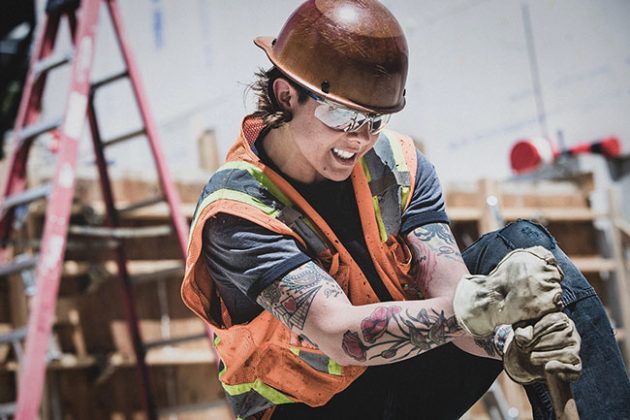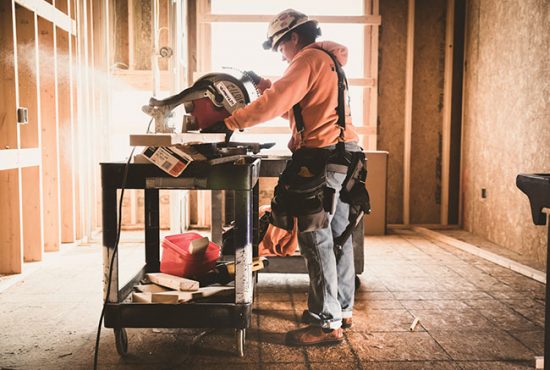
By Robin Skilling, Keen Utility
Best foot forward
Canadian Contractor In-Depth Women in Construction canada contractor ppe skilled trades women in constructionPPE built for women better prepares female workers for the skilled trades.
The current state of the economy shows an immediate need for workers following the COVID-19 pandemic, especially when it comes to the manufacturing and construction industries. But the bleaker picture is the state of these industries over the course of the next decade and the lack of skilled workers when it comes to filling the demand for the growing number of projects.
According to the government of Canada, between 2019 and 2028, about 700,000 skilled trades workers are expected to retire. Meeting the demand for anticipated projects will require the recruiting and training of thousands of additional skilled workers.
That being said, there is optimism around meeting these needs, as provinces and the government of Canada along with non-profit groups work together to encourage younger generations and untapped demographics to join the trades. One of the demographics that is essential to reach is women. However, there are still systemic barriers that need to be addressed in order to successfully encourage women to pursue careers in the trades.
In order to meet this high demand and elevate women in the industry, safety must remain a high priority for businesses looking to fill the gaps. This means women need the right protective equipment for the job ¬– and more importantly the right fit for the task at hand. For too long, women in the trades have needed to find workarounds for PPE designed largely for men. Gear and equipment such as boots, coveralls, goggles, gloves, respirators and even tools are mandatory for the jobsite. Despite this, many women may feel frustrated – and potentially unsafe – when using ill-fitting equipment. Keeping every employee on the jobsite safe is non-negotiable and can often be achieved by ensuring proper fit when it comes to PPE.

Innovation and advancement of materials in recent years have contributed to improved fit and functionality of PPE gear.
Recruitment is key to impending shortfall
Although Canada has experienced a small rise in the number of women joining the skilled trades, there is certainly room for improvement. In 2018, Statistics Canada reported that women accounted for roughly 47 percent of the national workforce. Of that, just 12 percent were in construction, and only an estimated four percent working in on-site jobs with the remainder holding off-site roles.
While there is a national movement to recruit all Canadians into the skilled trades, there are also programs that specifically focus on elevating women into these fields. In 2018, the government announced several programs to encourage women to join the trade movement including an Apprenticeship Incentive Grant for Women, a Women in Construction Fund and a new pre-apprenticeship program. These efforts hope to play a part in securing thousands of jobs for women in the workforce.
Further, this past May, parliament members secured nearly $900,000 in funding to the College of Carpenters and Allied Trades for a project housed under the Union Training and Innovation Program. This funding is part of the Government of Canada’s $62 million investment over five years to help develop a highly qualified skilled trades workforce and prepare Canadians to fill available jobs as the economy restarts. As part of the program, the College plans to implement online learning as a means of supporting a more diverse and highly skilled carpentry workforce.
On top of the national efforts, provinces and territories are taking it upon themselves to incentivize untapped demographics to take up the trades. One example is the Ontario government investing $47 million over the course of the next year to hire more apprentices, improve the quality of training and help them complete their training and certification through the new Achievement Incentive Program and the expanded Apprenticeship Capital Grant.
In terms of initiatives specifically focused on safety, the Builders Code is a pilot program in British Columbia whose main goal is to ensure the province’s construction employers adopt and champion human resource policies guaranteeing the equal and fair treatment of women. The initiative is focused on the retention of tradeswomen through improved policies and practices from employers. Research has demonstrated that equal and fair treatment of all employees and a feeling of inclusivity is essential for creating a safe and productive workplace.
Importance of PPE options for women
According to the Canadian Centre for Occupational Health and Safety, PPE is the last line of defense for a worker when it is not possible to eliminate a potential workplace hazard. However, if personal protective equipment does not fit properly, it is unable to be effective. Men and women are built differently (that is, size, height, shape and so on), so why should women be expected to wear men’s workwear on a jobsite?
CCOHS states: “All workers have a right to a safe workplace. PPE designed for the dimensions of an average male worker means that female workers may be forced to rely on gear that is too large or disproportionate. From headwear to footwear, ill-fitting PPE can cause safety hazards, reduced dexterity from oversized gloves, hard hats that fall off, baggy coveralls catching on equipment and trips and falls because footwear or shoe covers are too large.”
With this in mind, a 2016 study of female construction workers in the American Journal of Industrial Medicine found a majority of women reported fit problems with many types of PPE including gloves, harnesses, safety vests and work boots. The general complaint was that the equipment was too large to be worn effectively.
At the end of the day, addressing women’s safety needs on the jobsite creates a more inclusive and appealing working environment for them in the trades. When it comes to PPE, safety starts from the ground up. Proper footwear helps reduce the chances of slips, trips and falls along with crush and impact injuries on the jobsite. Additionally, the type of footwear can have a significant impact on comfort and all-day performance. Selecting the right work boot or shoe with the correct fit and appropriate features for the specific trade, task or environment can play a large part in making the days feel shorter and the job that much easier, not to mention safer.

While it is essential to choose a safety footwear that satisfies the proper industry standards, many women face issues finding a proper fit.
Putting the best foot forward
Fit matters. In fact, it’s critical. Women in the market for safety boots or shoes should seek out brands that design and fit their products for the specific biomechanics of a woman’s foot and a women’s-specific fit will help to lay the foundation for a better performing work boot. Other fit and safety features include an unobtrusive-fitting safety toe cap to give feet room to move, breathe and bend and a heel cup that makes wearers feel like their foot sinks back into the footwear as they lace the boot up, keeping the foot well-connected with a secure fit. These elements contribute to keeping the foot secure, comfortable and stable. Stability is crucial when it comes to safety on the job. Being able to trust each step can have a significant impact when it comes to preventing accidents.
Beyond fit, it’s essential to choose a safety footwear that satisfies the proper industry standards. This may include safety toe caps, electric shock resistant rating and metatarsal guards, among other requirements. In Canada, all CSA-certified safety footwear must include a puncture-resistant midsole plate for underfoot protection. In today’s market, some of the most important changes to the safety footwear has involved the innovation and advancement of materials to improve fit and functionality. For example, thanks to material improvements, puncture-resistant plates can now be flexible, non-metallic woven textiles, helping to reduce weight, improve flexibility and the ease of walking through metal detectors without sacrificing safety.
Other material advancements have bridged the gap between trades and trends. New materials such as non-marring, high-tensile-strength fabrics bring an athletic-inspired breathability and functionality to the safety market. This has led to the ability to create sportier, more sneaker-like silhouettes. Comfort materials and advanced compounds further add the cushion, support and energy return needed for long days on hard surfaces.
As a safety footwear manufacturer, we also have some insights on what to look for when selecting women’s safety boots and some best practices when shopping for safety footwear.
When it comes to finding the best fit for footwear, workers should try on shoes towards the end of the day when feet tend to be more swollen and at their largest. This allows for a better fit from start to finish of the work day and ensures that the shoe will accommodate any swelling without causing harmful restriction of the bloodflow to the feet. Both feet should be measured when shoe shopping as most feet are not the same size. Workers should also bring a pair of socks they would typically wear with their boots. Socks should provide cushioning and ideally be made of a moisture-wicking material like Merino wool, which offers natural antimicrobial keeping feet stink-free and dry. A smart sock choice can also prevent foot problems like fungal infections or blisters, which form from moisture being trapped in the sock.
Invest in the future of the trades
Now is the time for manufacturers and purchasing managers to invest in recruiting women to the skilled trades. That starts with creating a safe space for women to work – including proper-fitting PPE. By providing women with the safety equipment fit for them to tackle any job, we can better outfit the future of the trade industry in Canada. It is up to each business and work crew to set the bar for women’s PPE high and ensure that all employees feel safe and empowered to take on any task at hand.
Robin Skillings is the senior global marketing director for Keen Utility. In her tenure at Keen Utility she has spearheaded the “Tradeswomen Tested” program, enlisting some of today’s leading female tradeswomen to test and advise in the development of future women’s-specific safety products for the brand.


Leave a Reply